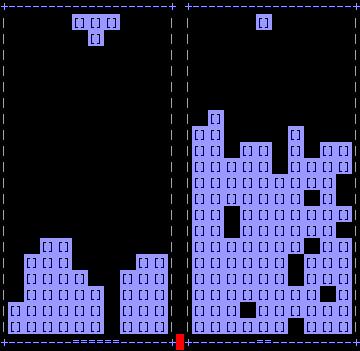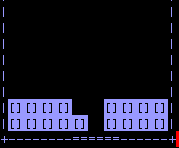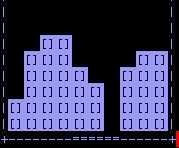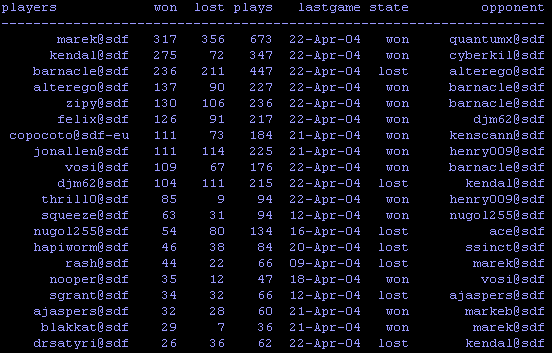I don't blog as much as I used to. But maybe that's ok. The other day, pesh and I went to go see 'the punisher,' which I enjoyed. I like these marvel comic book movies, because of the nature of the comic book hero. It's a similar archetype to the comic strip hero (charlie brown, calvin, opus, dagwood, etc): a social outcast, misfit or loser who is confronted by a world that doesn't accept him. This is a recurring theme for the marvel comic heroes: wolverine, the hulk, spiderman, and the punisher are all, essentially, 'dorks;' people for whom the standard sets of social and civilized mechanics just don't work. In 'the punisher,' the main character comes to live in a squalid apartment, and develops a relationship with two caricatured social misfits: a very fat man, and his friend with multiple lip piercings. I suspect that the writers created these characters by sampling the crowd at a comic book convention. It was established that these characters were the punisher's new family, because the world didn't accept the punisher, just as it didn't accept these variously fat and pierced outland-dwellers. So, the comic superhero always has that element of iconoclasm, of not being 'one of the popular kids.' I think this is why both comic books and comic strips appeal to people who see themselves as not fitting in; they celebrate that strata of society. Charlie brown and wolverine: brothers-in-arms.
I have to go over to mrs. White's house in a few minutes, and take care of abner. Then, someone from the c&o canal association is going to pick me and some shoes for mrs. White up, and take us (me and the shoes) to a Maryland town, somewhere along the length of the potomac river between cumberland and washington DC. Mrs. White needs better shoes on her hike. So, I must leave you, and go feed abner. I mowed mrs. White's lawn yesterday, and it was actually kind of fun. I enjoy having a little domicile that I can care for. Last night, I watched Star Trek over there and petted abner, rather than watch it over here and pet no one.
As always, the postmodern excitement continues in gaithersburg. But I really must be going.
I got back from...somewhere in Maryland beginning with a 'w.' let me look at a map. Williamsport -- that's it. Anyway, it's full of historic, canal-related ambiance, but seems really terrifically boring. You know you're out in the sticks when white people are working at the local mcdonalds.
So, these two people whose names I will omit (one of the two didn't want her email address to be posted on the c&o website, so I suspect that she would prefer not to be mentioned in some psycho's blog) picked me and mrs. White's shoes up. Then, we drove to williamsport, where mrs. White would be, along with other hikers. She's on this outdoor adventure called a 'through hike,' which is a 2-week hike *through* the whole 184.5-mile length of the canal, from cumberland to georgetown. My secret drivers and I were there for two reasons: to give mrs. White her shoes, and also because bill justice needed a body. Someone named bill justice was scheduled to give some kind of speech, fanfare or ceremony, and apparently he was afraid that not enough people were going to be there, and he'd be all embarrassed and be giving this big presentation to one old guy wearing a t-shirt. So, the secret people's and my secondary mission was to be an audience for bill justice. One of the secret people kept saying 'bill justice needs a body,' so I got that in my head, and was repeating it to myself over and over: 'bill justice need a body.'
But it turned out bill justice never showed up, and apparently the national park service was to blame. This is a good example of the confusion that pervades every waking moment of my life. The world just does not make sense. So, rather than get upset, I try to go with the flow, murmur 'bill justice needs a body' to myself, and lie down on the grass a lot (i was coming down with a feverish cold at that point). Bill justice needs a body. The funny thing is that the hike mrs. White is on is an anniversary re-enactment of 'the hike that created a park,' the preservation of the c&o canal by justice william douglas by taking various people of import and influence on the 184 mile hike in 1954. So we have justice bill douglas, and then bill justice, in modern times, who needs a body. But I had a good time with the secret people, and gave them each a popsicle from mrs. White's enormous freezer stash when I was dropped off. My adventures for the day. Also, the secret people bought me a lovely lunch at mcdonalds: a double cheeseburger, mcchicken sandwich, and small fries.
I'm sick. I'm pretty sure pesh 'got me sick.' I find it annoying when people blame others for 'getting them sick.' kill all humans. Kill.
"It is high time that netris-players should openly, in the face of the whole world, publish their views, their aims, their tendencies, and meet this nursery tale of the spectre of netris with a manifesto of the game itself."

First of all, prospective players need an account at sdf.lonestar.org. telnet to ol.freeshell.org and follow the account creation instructions. Then, I'd recommend logging out, and connecting with SSH to tty.freeshell.org. Once you're inside, type 'com' to enter the chatrooms. To invite another user to play netris, type 'n user@server.' a list of users in a room along with their particular servers (user@server) is displayed when you type 'w.' to accept an invitation, the invitee simply hits 'n' once s/he sees ‹user1@machine invites user2@machine to play netris›.
Invitation isn't without pitfalls, and problems can result if two users invite each other at roughly the same time. For this reason, and to avoid being stuck in a blank screen limbo waiting for the game to start, it's good to establish that someone actually wants to play before one invites them, and to clarify who will do the inviting and who will do the accepting. If there are three users interested in playing, then the third player might play the winner. However, a rivalry between two players sometimes supersedes this courtesy, and two will just keep playing each other while ignoring the third. With four interested players, no one follows any algorithms for who-plays-who. Sometimes, the four will pair off, or just a random netris orgy will ensue. In a series of games, generally the loser (or challenger) carries the burden of invitation.
Netris primarily taxes visual processing speed (how quickly one can rotate shapes in one's head and build receptacles based on the likelihood of a matching shape dropping next), which probably would make it ideal cognitive therapy for brain injury sufferers. It would be interesting if ability in netris correlated to ability in other areas, such as programming, mathematics, driving, drawing, etc, or if it corelated to traits such as orderliness, or something weird like depression or homosexuality (a study waiting to happen). However, it's possible that netris is an island unto itself.
Each player's netris board is 10 blocks wide, and 20 blocks high. ‹j› moves a piece one block to the left, ‹k› rotates a piece clockwise, ‹l› moves a piece one block to the right, and ‹space› drops a piece all the way down. Each player can pause with ‹p›, and only the player who initiated the pause can un-pause by hitting the same key. Pieces can be nudged one over to the right or left immediately after dropping. More than two rows cleared appear on your opponent's board -- this is what makes the strategy in netris, which is to vanquish your opponent, different from that of tetris, which is merely to stay alive as long as possible.
Good netris play has three principle sources: playing quickly, playing flat, building 'likely shapes,' and undermining your opponent. There's also a significant amount of luck involved, in the randomness of appearing pieces (statistically a 1/7 chance that a given piece will appear, although netris is subject to the same problems with random number generation as any digital system).
Obviously, a player who builds more quickly will be at an advantage, as opportunities for multiple row-clearings (and their deposit on one's opponent's board) will therefore come more quickly. Familiarity with the seven possible pieces and their various rotations makes quick play easier. Also, on the very bottom of the board is a single-pixel line that indicates a piece's horizontal position, which is helpful to avoiding placement errors.
It's also important to play flat. By this, I mean literally making the upper surface of the bottom mass of blocks as level as possible, leaving one (or occasionally two) holes intended for a 2-4 row clearing opportunity. If one 'plays flat,' then when one's opponent clears 2-4 rows and they are transferred, in their state before they were cleared, to one's own board, then recovering from this onslaught becomes a more trivial thing. For example, if your opponent clears 4 rows at once by filling in a hole with an I-shaped piece, then those rows, *including the original hole*, will be deposited underneath your current bottom block-structure. If you are 'playing flat,' then clearing the opening to this existing hole is much easier, and you can then turn the tables on your opponent quickly.
Building 'likely shapes' is more or less the same thing as playing flat, but takes the theory in terms of individual instances of structure-building, rather than a holistic approach. For instance, there are two pieces that will fit this recess, thus it's helpful to build it:

Conversely, it's unhelpful to build recesses that are statistically unlikely to be met with fitting pieces. This shape relies on two I-shaped pieces to fill both holes, and is therefore generally undesirable, especially with a large deposit of bottom blocks (having a height of about half the screen):

Undermining your opponent involves setting up shapes that will cause a descending piece to clear multiple rows when it fits into the structure of bottom blocks. This is crucial -- in most cases, playing purely defensively (ie, just trying to keep your bottom block structure as small as possible) will result in a loss. In this way, netris rears its competitive, aggressive head. So, more often than in tetris, netris players will shape their boards to contain long holes, waiting for L-shaped or I-shaped pieces to appear, fill the holes, immediately clear 2-4 rows, and thus make life difficult for their opponent. Of course, this waiting game rapidly becomes dangerous, and is a matter of risk-management and cost-benefit: if that long piece never comes, then two towers are gradually built on either side of the waiting pit, a situation from which recovery can be nigh impossible.
On the subject of undermining, I find that a good rule of thumb is to avoid clearing single rows, but rather to try and eliminate 2 or more every time. Inevitably, chance will allow the opportunity to clear 3 or 4 rows on occasion. Of course, sometimes it's impossible to avoid clearing only one, when the base structure simply doesn't allow for any alternatives. However, clearing single rows as quickly as possible is an effective defensive strategy if the bottom structure gets to be alarmingly high.
It's also worth mentioning that each player gets the same sequence of pieces, and that if one's opponent is playing faster, then it's helpful to keep an eye on his or her board to get an idea of what might be coming up.
Finally, the phenomenon of machine lag is an inevitability of netris. Lag might come from SDF machines being overburdened, an ISP being overburdened, or one's own connection being overburdened. Since lag is almost universal to some degree (especially when play is spread over many games), it makes sense to consider lag part of the game. As kendal points out, 'you should be playing well enough so that lag shouldn't be a problem.'

This is the ranking system (on 22 apr 04), viewable in SDF com by typing 'N scores.'
I take some issue with the scoring algorithm. For instance, according to the ranking, I am the third best player, which is simply not the case. In fact, as is indicated by my win:loss ratio, I'm about average.
As it is, players are ranked in terms of their total number of wins, regardless of losses or the ranking of the players they've beaten.
So a player who is less skilled than another can manage a higher rank by electing only to play less skilled opponents, or simply by playing a large number of games.
A ratio of wins/losses wouldn't work too well because, as kendal pointed out, if someone played only one game and won it, s/he could retire at #1.
I'd propose something like limiting the list to players who have played 50 or more games, then ranking in terms of wins:losses, but weighting wins over more highly-ranked players.
There is also a function to view one's 'greatest rival' (the player who has holds the most victories over one) and the record, which is the longest game. This is actually a really nice feature, since it introduces a socialist, noncompetitive element to netris play: if two players are very skillful, then they can extend a game to 200, 300, or even 700 seconds. However, this feature is undermined by the fact that games paused by either player continue to run the clock. So, as often occurs, if a player is at work and needs to pause to hide from the boss, perhaps for several minutes, then these minutes get added on to the game. I'm not sure how easy this issue would be to solve, since it would involve coding both at sdf and in the netris program.
There two pairs of analogous activities that are crucial to survival. These two pairs can be thought of as 'selling' and 'buying.'
The first pair is 1. Job-hunting, interviews, resumes -- the whole employment-seeking process, and 2. The mating game -- going on dates, responding to personal ads, dressing up, and presenting one's self in a certain way. Essentially, applying for jobs and applying for girls. These activities are disturbingly similar. In both, one is selling one's self, saying 'here I am...look at me...will you accept me?' applying for girls and applying for jobs are both made more effective by increasing scope. In fact, increasing scope supersedes in importance the quality of an application; the more girls or jobs you apply to, the more likely it is that you'll get a girl or a job. I represent this pair as 'selling.'
The second pair is 1. Dealing with money -- managing it, conserving it, optimizing it, deciding when to spend it and when not to spend it, and 2. Dealing with food/weight gain: managing one's intake and body size, counting calories, and exercising. Deciding when to eat (when one is hungry? When the clock hits a certain number? What defines 'hungry'? If you hear your stomach audibly growl? Is it a feeling? Digestions sometimes feels extremely similar. When do I eat? I'm confused), and employing the same delayed-gratification mechanisms that are necessary in saving money. Saving money and losing weight. I represent this pair as 'buying.'
I am fucking terrible at all four. Luckily, I landed a girl without having to go through the interview process, and for this I'm grateful. I can hopefully cut this activity out of my life permanently -- no more applying to girls for me. Those days are over. But I can't manage my money, can't manage my weight, and can't manage my job hunt.
I would like to take classes on those three things. I think if those were offered, 22 year-olds coming out of college would be a lot more prepared to take on the world, so to speak, than they are now, with their 'degrees' in psychology, english, basket-weaving, or whatever. I could also take classes on applying for girls, and maybe apply it to social dynamics in general.

First year
Third year
Fourth year
The last semester seems kind of easy, which is nice.
Unless I regularly earn a significant amount of money, I don't plan to pay my student loans back, and I don't feel that I should feel any sense of social obligation to do so. I took those loans out with the understanding that I would be professionally prepared at UMBC for a career in web-development. This didn't happen, so I feel that there was an implicit breech of contract that nullifies my contractual obligation to repay my student loans. So, if the federal government wants its money back, they'd better offer me a job.
There's also the element of my settlement from my car accident, and my 1999 investment of that money in the stock market. I also consider this a cultural dupe in line with UMBC's marketing lies about the nature of their 'imaging and digital arts' program. If I hadn't 'invested' that money, I would have been able to pay off my school loans, almost in full. I don't feel that I am now obligated to pay back that money, considering the circumstances.
I've just sold my first piece of artwork. I think now, I can in some capacity officially refer to myself as 'an artist.' I'm not sure what the statute of limitations is, however. If I don't sell anything in...what...a year, three years? A decade? At that point am I no longer an artist?
Whatever -- the definition of 'artist' is a personal one; if one feels like one is an artist, then one is an artist. If I've been, say, selling work consistently (as in, at least 4 pieces a year) for at least a year, then I would have no problem calling myself an artist. I guess if I sold 3 pieces (or even 2) in a row, within a span of...hmm...two months, maybe? Or at all? Hehe. Maybe I'd be an artist then. I don't know. The point is, selling these peeps made me *feel* like an artist, for probably the first time. I felt like an artist from time to time in college, but that was transient, and always tainted by the fact that it was being subsidized with tax money.
I'm afraid I don't approve of the NEA. If art isn't desired enough by the community (or the artist himself) enough to sponsor it financially, then that's a pretty good sign that the 'art' in question shouldn't exist in the first place. One of the most socially irresponsible situations I can think of is that of university fine arts professors. They are often tenured faculty, and are paid enormous salaries by the state government not to teach -- teaching is secondary -- but to do 'research.' and 'research' for an artist in academia amounts to making art. And it's not very good art. No one cares about it -- it excites no-one except other academics; other members of a self-supporting, self-sustaining club of pony-tailed turtleneck-wearers, who feed off of one another. Of course, it's not kind to tell people like this to go get a job, to stop siphoning from the paychecks of construction workers, police officers and secretaries. But let's call it what it is: charity. Paying an 'art professor' at a state university $80,000 a year to make 'conceptual art' doesn't enrich anyone's lives except the art professor's himself, and those of his various minions within the academic community. It's fine to be compassionate and pay those who are unable -- even unwilling -- to work, enough money so that they can live, keep warm, stay fat and even entertained. What's not 'ok' is referring to such charity as 'tenure' or 'research,' or even a 'salary.'
It's not that I feel art should strictly be a commodity. If an artist has charitable patrons, or the artist makes work for himself, or even if a private company wants to commission someone, then that's fine. I guess I take issue with public money going into grants and art prof salaries. Maybe I'm more libertarian that I thought. I don't know.
Clearly if there are people suffering, and private industry and individuals aren't cutting the mustard when it comes to helping them, then certainly help them by any means necessary, including extracting public funds (by threat of physical coercion?), regardless of ideologies. But my abstraction-rooted, intellectual (this doesn't mean I'm calling myself smart -- just that I don't live reality) nature likes all-or-nothing models of reality, reductionism and oversimplification.
But I still don't think art should be publicly funded.
In other news, my bunnyranch piece now outranks the official bunnyranch site on google search term 'bunnyranch.' I wonder if I'll be getting a call from dennis hof.